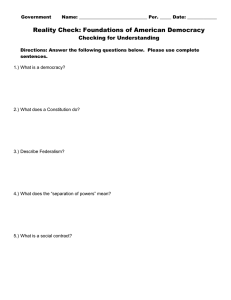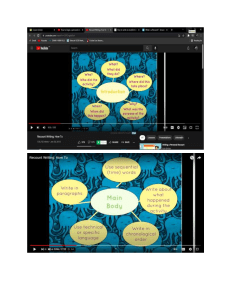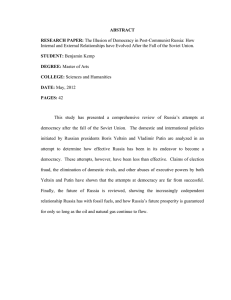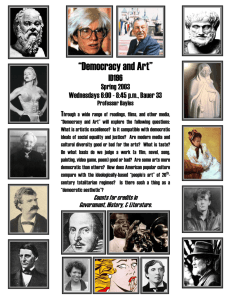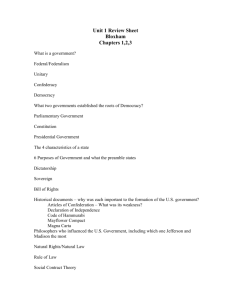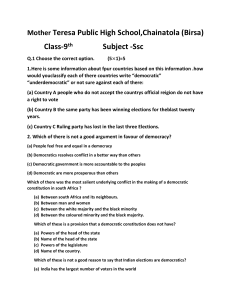Political Science Lecture Notes: Elections, States, Constitutions
advertisement
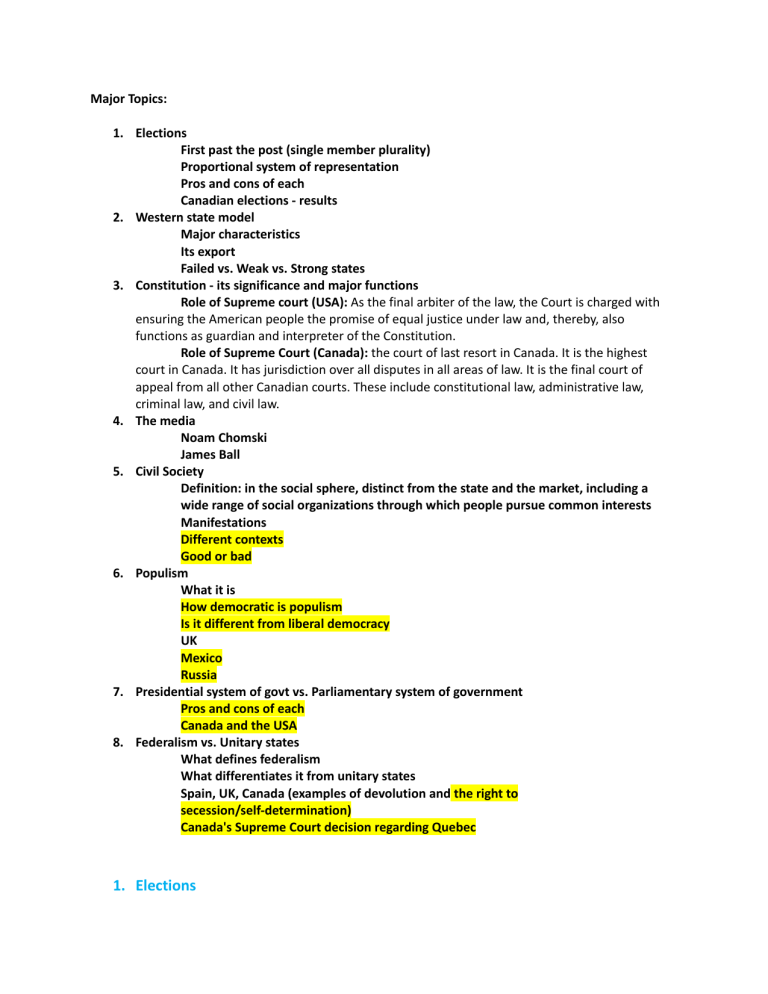
Major Topics:
1. Elections
First past the post (single member plurality)
Proportional system of representation
Pros and cons of each
Canadian elections - results
2. Western state model
Major characteristics
Its export
Failed vs. Weak vs. Strong states
3. Constitution - its significance and major functions
Role of Supreme court (USA): As the final arbiter of the law, the Court is charged with
ensuring the American people the promise of equal justice under law and, thereby, also
functions as guardian and interpreter of the Constitution.
Role of Supreme Court (Canada): the court of last resort in Canada. It is the highest
court in Canada. It has jurisdiction over all disputes in all areas of law. It is the final court of
appeal from all other Canadian courts. These include constitutional law, administrative law,
criminal law, and civil law.
4. The media
Noam Chomski
James Ball
5. Civil Society
Definition: in the social sphere, distinct from the state and the market, including a
wide range of social organizations through which people pursue common interests
Manifestations
Different contexts
Good or bad
6. Populism
What it is
How democratic is populism
Is it different from liberal democracy
UK
Mexico
Russia
7. Presidential system of govt vs. Parliamentary system of government
Pros and cons of each
Canada and the USA
8. Federalism vs. Unitary states
What defines federalism
What differentiates it from unitary states
Spain, UK, Canada (examples of devolution and the right to
secession/self-determination)
Canada's Supreme Court decision regarding Quebec
1. Elections
First past the post (single member plurality)
Proportional system of representation
Pros and cons of each
Canadian elections - results
Elections: a form of choosing political representatives whereby individual citizens cast their votes for
their preferred candidate.
Single Member Plurality System: One representative per geographic area (riding, constituency, district)
aka ‘First-past-the-post’, ‘winner-take-all’ system
●
●
●
●
●
Pros:
Clear voter choice
Single-party govt
Coherent opposition in the legislature
Constituent-rep link
Easy 2 understand
●
●
●
●
●
●
Cons:
Exclude smaller parties
Smaller party rep smaller voices eg. Ab language barriers)
Rewards concentrated identity-based parties
Wasted votes (only winning votes end up mattering)
Vote splitting
Less responsive to/rep of electorate
Proportional Representation
● Representation (# of seats) directly proportional to the share of the popular vote received (# of
votes)
● Mechanics:
○ party lists
●
ranked-choice voting
●
●
●
●
●
●
●
●
●
●
●
Pros:
Faithful to voter outcome
Encourages coop among similar parties
More rep of societal interests/identities
Greater policy continuity and stability
Increased power of legislature
More parties in legislature control power of the house, which allows 4 increased negotiations
Cons:
Possible legislative gridlock
Decreases accountability
○ Who's at fault for probs that arise when there are 2+ ppl in power
Difficult to understand
Small parties have too much power
○ Can sway govt more b/c smaller
Fragmentation party system
○ Ppl may only be voting for parties which specifically apply to them rather than the
greater good of community
SMPS and Democracy v. PR and the Democratic Ideals
SMPS
PR
Popular
sovereignty
Direct rep-cit link
No direct rep-cit link
Maj govt
Yes but not necessarily majority
rule
Unlikely
Minority rights
Prospect for minor national
parties
Better rep of minorities
Political equality
Wasted votes
Every vote counts
More competition - more choices - more rep of
public opinions, minorities, diverse interests
Canadian Election Results (2015)
Vote (%)
Cons.
NDP
BQ
Libs
31.9%
19.7%
4.7%
39.5%
Seats (338)
Seats(%)
Diff.
99
29.3%
- 2.6%
44
13%
- 6.7%
10
3%
-1.7%
184
54.4%
+14.9%
Green
3.4%
1
0.3%
- 3.1%
2. Western state model
What is it? *missing
Major characteristics
Its export *missing
Failed vs. Weak vs. Strong states
What is it?
Major characteristics
- Subordination of the military to civilian control
- Professional bureaucracy
- Fiscal surveillance
- The parliamentary structure (a democratic form of government where the party with the
greatest representation in the parliament forms the government)
- independent court system
Failed, weak and strong states
Strong state: a state that is generally capable of providing goods to its citizens
Weak state: a state that only partially provides goods to its citizens
● security gap, capacity gap, legitimacy gap
Failed state: a state that loses effective sovereignty over part or all of its territory
● Lack of stateness
○ Weak institutional structures
○ System of personal rule w/o aim to provide public goods (patron-client
relationship)
● Lack of political identification with state
○ Ethnic identity connected to tribal, religious, and similar characteristics
continue to dominate over national identity
Characteristics: Poverty, Terrorism, AIDS (25 million only in Africa); spread of contagious
diseases, Drug trafficking, Corruption, Ethnic conflicts
The Spread of the European State System
- North America and Australia; but also South America
- Japan set a constitution in 1890
3. Constitution
its significance and major functions
Role of Supreme court (USA)
Role of Supreme Court (Canada)
What is constitution?
●
●
●
the body of fundamental laws, rules, and practices that defines the basic structure of
government, allocates power among government institutions, and regulates the relationship
between citizens and the state.
○ Lay foundation for power relations between:
○ different parts of state ( horizontal power relations)
○ Different levels of gov’t ( vertical power relations)
OR, refers to specific document(s) (codified) that embody legal rules of constitution
Written (codified) v. Unwritten (uncodified) constitutions
○ Example of codified: BNA act, charter of rights and freedoms, constitution = written
Constitutional conventions
an unwritten (uncodified) binding rule of behaviour that fills in gaps in the written constitution
and conditions that exercise of legal powers under the constitution.
● While considered obligatory, such rules are not legally enforceable.
● Eg. USA, Canada
●
Importance of constitutions:
● to ensure that everyone’s rights and freedoms are fulfilled.
● A basic political language of our values, the general power of the government system…who
holds the power? Under what limitations?
Constitutional functions:
1. Define the structure of major institutions of government
2. Divide powers and responsibilities among different institutions of government
3. Regulate relations between citizens and states
4. Provide a unifying national symbol
5. Specify how to amend the constitutions
American Supreme Court
● Consists of chief justice of the united2 states and 8 associate justices
● Each justice has lifetime tenure, when there's a vacancy prez appoints new justice w advice from
Senate
● Each justice has single vote on cases
Notable Supreme Court decisions:
1. Dred Scott v. Sanford (1857)
● Slave Scott filed for Freedom b/c he resided in Illinois which is a free territory
● Ruled against scott b/c slaves aren't Americans
○ Constitution didn't consider black ppl as being held within political framework
2. Plessy v. Ferguson (1896):
● The Court's famous "separate but equal" ruling upheld state segregation laws.
● Court made sure gains of post civil war reconstruction were quickly replaced w/ Jim
Crow laws
3. Brown v. Board of Education ('54)
● Overturned Plessy v. Ferguson 'separate but equal'
4. Roe v Wade ('73)
● 1973, the Court ruled in a 7 - 2 bipartisan decision in favor of Jane Roe.
● Right of privacy was at the heart of the court’s decision.
● Justices cited the 14th Amendment’s concept of personal liberty aligning with a woman’s
right to make a decision to terminate her pregnancy.
● Justices rejected the notion of a “fetus’s right to life,” which has now become a rallying
cry amongst conservative activists
Role of Supreme Court (Canada)
● the court of last resort in Canada. It is the highest court in Canada.
● It has jurisdiction over all disputes in all areas of law.
● It is the final court of appeal from all other Canadian courts.
● These include constitutional law, administrative law, criminal law, and civil law.
Major functions
1. Create a national government consisting of a legislative, executive and judicial branch
2. Divides power between the federal government and states
3. It protects various individual liberties of American citizens
- Constitutions are the foundational law
- Are foundational: provide body of rules and principles according to which a state is governed.
- Fulfill democratic requirement of rule of law
- Explains who/what institutions are to carry out major functions of government ( U.S vs. Canada)
- Basics rights and obligations of citizens
- Basic source of national law
- Reflect a country’s history and values
- Lay foundation for power relation s between:
different parts of state ( horizontal power relations)
- Different levels of gov’t ( vertical power relations)
- -government and citizens
- Basic rights and obligations of citizens
- The political system
Role of Supreme Court USA
● To inform a more perfect union
● To establish justice
● To ensure domestic tranquility
● To produce for common defence
● To promote the general welfare
● To secure the blessings of liberty to ourselves and posterity
● started by 1st Congress through the Judiciary Act of 1789, a chief justice, eight associate justices
4. The Media
Noam Chomski
James Ball
James Ball
How bullshit conquers the world, public life is increasingly run by people who don’t care much about the
truth, they care about the narratives, The business model of the media does not rely on circulation
revenues but on the advertising leading to the loss of independence, covering an international report is
expensive, every click on fake news is revenue
POST-TRUTH: how the bullshit conquered the world
● Someone who lies and someone who tells the truth are playing on opposite sides, so to speak, in
the same game. Each responds to the facts as he understands them, although the response of
one is guided by the authority of the truth, while the response of the other defies that authority,
and refuses to meet its demands (Harry Frankfurt, 2005)
● You can sway a thousand men by appealing to their prejudices quicker than you can convince
one men by logic (Robert A. Heinlein)
● Idea that those who lie and don’t, don’t know the truth
● The bullshitter ignores these demands altogether. He does not reject the authority of the truth,
as the liar does, and oppose himself to it. He pays no intention to it at all. By virtue of this,
bullshit is a greater enemy of the truth than lies are (Frankfurt).
● In other words, public life is increasingly run by people who don’t care much about the truth,
they care about their narratives.
● Write what they want, they don’t look at it like the public would. Provide their own opinion
Why is bullshit in ascendency?
●
●
●
●
●
Technology, the rise of internet
But also, new economics
The business model of the media does not rely on circulation revenues but on the advertising
leading to the loss of independence
Assigning a reporter to cover an international event is expensive
it is easier to write an original claim, publish it and later worry about rebuttals to such a claim.
Reliance on fake news sites –even the mainstream media allows on its sites fake news addresses since
every click on those sites bring some revenue to them
●
●
●
●
●
Thus while critiquing the fake news phenomenon, the so-called “serious” media is
simultaneously feeding and profiting from such fake or hype news.
Everyone can go and write about what they want
Business model is about what will survive and gain profit
We buy into the news, and nowadays it is clearly not as rich
Knowledgeable journalists barely exist now
Reliance on fake news
●
●
If you read online newspapers, there are always ‘strange’ links, and these are the sources of fake
news and provide the original website w profit
News Sources -Have political aspects, these alone funnels and shape the media
Five filters of mass media machine –Noam Chomsky
●
●
●
●
The death of objectivity “relieves me of obligation to be right,'' It “demands only that it (my
story) will be interesting” (Stanley Fish)
Media is NOT a check on political power, does NOT inform, serve the public to help us better
engage in political process
Democracy is staged bc media = propaganda machines
Consent is manufactured
5 Filters:
1. Media Ownership
● Size, ownership and profit orientation of the mass media
● In corps interest to do whatever ensures them profit
1. Advertising Money
● The real role of advertising
● Advertisers are paying for audiences
● Media is selling advertisers a product - you!
1. The Media Elite (govts, corps, big institutions)
● Sourcing news –defining and controlling a “newsworthy” content- gatekeeping
● How establishment manages media
● Journalism can't criticize power b/c the system encourages complicity
● They make themselves crucial to journalism through scoops, official accounts, interviews
w/ experts
1. Flack
● “Flack” refers to negative responses to a media statement or program aired on the
network. Perhaps the most influential producers of flack are corporations and the
government. This creates the image of objectivity.
● When story is inconvenient to the elite, there's flack eg. Discrediting sources, trashing
stories, divert conversation
1. The Common Enemy
● Eg. Communists, terrorists, immigrants, are 'common enemies' that public fears which
helps corral public opinion
● Anti-communism as a control mechanism –today, anticommunism is replaced with
antiterrorism
5. Civil Society
Definition
Manifestations *missing
Different contexts *missing
Good or bad *missing
Definition: Social sphere, distinct from both the state and the market including social institutions and
organizations where people pursue common interest
● These can include:
○ Formal organizations (labour unions, professional associations, voluntary organizations,
etc.)
○ Informal “organizations” such as
■ Spontaneous, loosely organized networks and social movements
● The relationship between civil society and political authority
○ Working together, or pulling each other apart
● social institutions and organizations that are independent of the state which citizens pursue their
interests, express their beliefs and live in communities
● any gathering of people who share common goals and activities etc.
● also includes interest groups
Manifestations
● Promote political participation
● Keep govt accountable
○ Eg wall street protest ab corp influence on democracy
● Promote equality
○ Eg Idle No More Movement
■ Wanted to take stand against Harper govt's disrespect for indigenous rights
● Promote civic education
● Advocate
○ Eg. Climate change, wearing fur
● Recruit/train political leaders
Good or Bad
Problems w civil society
After obama elected, conservatives formed 'tea party' movement
● 'true patriots' 'authentic american values'
● 15 non-negotiable core beliefs
○ Illegal aliens should be expelled
○ Gun ownership sacred
○ Reducing taxes mandatory
○ Traditional fam values encouraged
○ Strong military is indispensable
○ English core language
○ Govt must be downsized
●
●
●
●
Problems with the concept of civil society
Is 'civil society' analytical or normative
Does it imply altruistic commitment
Could it include bad groups like mafia, fundamentalist religious groups, ultra-nationalist groups
Do existing inequalities in society favour some groups in civil society over others?
6. Populism
How democratic is populism
Is it different from liberal democracy *missing
UK
Mexico
Russia
How they relate to populism
What is it
Populism ... separates society into two homogenous camps/groups, ‘the pure people’ and the ‘corrupt
elite,’ and holds that politics should be an expression of the ‘general will’ of the (right kind of) people. In
principle, populism presents itself as democratic but is always illiberal.
Jan-Werner Muller
● Equally at home on the left and right
● Populism is a necessary dimension of a democratic politics
● Populism is a powerful reaction to a sense of extreme crisis
● populism is like a chameleon, adopting the colours of its environment
● Populism
As an ideology: LACKS core values
As a movement: Simple and attractive
As a govt: Less-than-stellar record (Venezuela, Turkey)
How democratic is populism?
- Modern liberal democracy is an uneasy combination of the two fundamentally different sets of
principles, liberal on the one hand (concerned with individual rights, universal principles, and the
rule of law) and the populist/democratic on the other (the sovereign will of the people, typically
expressed through referendums).
- In times of crises, and when liberalism takes over democracy, we are witnessing the rise of
populist waves.
Is populism different than liberal democracy?
Mexico
Populism in Mexico
-
GDP 2.149 trillion - #14 in the world.
GDP per capita is only 18,000
Population below poverty line - 52.3%
Exports $398.3 billion - #15 in the world.
Reliance on manufactured goods and oil production.
Mexican Politics
-
Complex indigeneous populations before spanish colonization
Attempts to create democracy, but quickly subverted by successive caudilos, eg Santa Anna.
30 different presidents in republic’s first 50 years.
1875-1910 Porfiriato: economic development for elites, foreigners, democratic rights suspended,
dictatorship.
Revolution of 1910: (10% of the population died.) democratic constitution 1917.
Mexico’s Centralized Political System
-
The president has control over all three subdivisions of the system.
The president can control the executive, legislative and judicial systems in the country.
The president controls the chamber of deputies, the senate and can appoint the courts.
The reason why the system is so centralized is because there was one leader for a very long
time.
The PRI would appoint state senates.
Corruption is Rampant
-
Civil law system, with constitution 1917 at apex
But hampered by partisan judicial appointments, corruption at level of police and courts
Full judicial reform, new criminal procedures by 2016 - but this has failed to end corruption.
PRI: Partido Revolucionario Institucional
Internal Security Concerns
-
Initiated by president Felipe Calderon (2006)
6,500 federal troops sent after cartels.
By 2013, death toll estimated as high as 120,000
Arrests of cartel leaders have destabilized system, causing fights for succession.
The Bumpy Road to Free Elections
One Party dominance
- Partido Revolucionaria Institucional (PRI)
- Legacy of regional “bosses”
Election fraud 1988
2000 election significant
- Vincente Fox (PAN)
Interest Groups vs. Social Movements
-
‘State corporatism’ by PRI as means of integrating interest group concerns.
But active social movements outside the state
Supportive Political Culture?
-
“overall , great majority of Mexicans support and value democracy… but the prevailing political
culture in Mexico expresses comparatively low support for democracy and relatively high support
for non-democratic government, on the one hand, and low interpersonal trust, low levels of
tolerance, and a strong emphasis on deference, on the other…” - World Values Survey
July 1st, 2018 National Elections
-
Andres Manuel Lopez Obrador (AMLO) and his leftist MORENA party dominated Mexico’s
presidential and legislative elections
AMLO won 53.2% of the presidential vote, and he won in 31 of 32 states.
MORENA’s coalition also won majorities in both chambers of congress.
Record levels of violence, 150 candidates killed
Yet international observers considered the elections free and fair.
Russia
Russia - Between Continuity & Change
Key Questions
-
The question of the political order
The question of implementing the most effective strategy of economic development
The question of societal control over the state: political transparency and the rule of law
The question of identity.
Totalitarianism
-
Authoritarian political system that controls not only most social interaction, but also marked by a
desire by the government to force its objectives and values on citizens in an unlimited manner.
The New Cold War and the End of the Soviet Empire
-
The soviet invasion of Afghanistan in 1979.
Polish crisis in 1981.
Ronald Reagan’s strategic defence initiative (Star Wars initiative.)
The rise of Mikhail Gorbachev to the post of the party secretary in 1985.
Perestroika (process of reconstruction) and glasnost (political liberation) in Eastern Europe.
1989 - Annus Mirabilis
Russia as an illiberal democracy?
-
Rule by decree and presidential flat as a standard operating procedure.
Weakening of the legislature.
Ignoring of the system of checks and balances.
War in Chechnya 1994-96; 1999.
Bypassing (streamlining) the elections by appointing Putin as acting president in 1999.
Perpetuating a dysfunctional state: strong in military and police capacities, but weak on the rule of
law and institutional effectiveness.
The Results of the Reform
-
The former soviet economy is gone, but;
At the price of;
Hyperinflation
-
Crippling of industrial output throughout the 1990s
Plummeting unemployment rates.
The rise of oligarchs and mafia capitalists (corrupt capitalism)
Vladimir Putin
-
Judoka, reformer, bureaucrat & autocrat.
The normalization of the russian state and economy depends on the states ability to establish a
legal economic and societal framework.
Putin’s targeting of the oligarchs has been selective, following the principles of soft
authoritarianism - patron-client relationship.
Replaced traditional-style ideologies with nationalism.
But also, Russia witnessed the increase of the standard of living leading to a popular support for
Putin.
Russia’s Complex Federalism
Four types of regions in Russia (89 subjects)
- 21 republics - homelands of major non-Russian nationalities, each elects a president.
- 49 oblasts (regions), mostly populated by Russians, elected governors
- 11 autonomous okrugs (districts), ethnic portions of oblasts or krals which claim special status.
- 2 cities of federal significance, Moscow and St. Petersburg.
Russian Semi-Presidential System
-
Presidency
Based on the french model of presidential-prime ministerial duality.
President is directly elected in popular elections (four-year term; but as of 2012 - 6 year term)
Appoints prime minister (must be approved by Duma), presidential administration and security
council.
Proposes constitutional court, supreme court and superior court of Arbitration.
Can dissolve federal assembly (Duma) in some circumstances.
Political Competition
-
Russian parties of power
Parties created by the elites to support their respective political aspirations.
1999 elections - two contended paties of power emerged
Fatherland-All Russia (former Prime minister, Primakov and Moscow mayor, Luzhkov)
Unity - party supporting Putin.
2001 - United Russia - two parties merged into one after Putin’s supporters defeated
Fatherland-All Russia.
United Russia
Putin personality cult (but Putin is not officially controlling the party, Medvedev is the official leader
of the party)
Stability and conservatism
Market reforms but controlled by the state
Moral values
-
Return of Russia to the status of a great power.
Russian Parliament
-
Weak parliament/super presidency under the guise of a semi-presidential system
Dependent judiciary
Lack of a strong reform party - by not belonging to one party, Putin institutionalizes himself above
the party system.
Dismissal of elected regional governors and their replacement with Kremlin-appointed political
figures in early 2000s.
The use of law as a political weapon in Putin’s struggle against the oligarch
Increasing control of media (particularly tv)
Sistema - an informal system of rule in Russia (Alena Ledeneva)
-
-
Soviet sistema was associated with the theoretical tenets of socialism - no private property,
centralised planning, political and ideological rigidity.
Nowadays, it is all about the wealth accumulation (the party ideology has given place to market
interests, state property to privatised assets, informal exchange of favours to monetised
kickbacks, planning to the constraints of global finance, local-bound infrastructure to hi-tech
technologies.
Power networks that channel informal influence function in an ambivalent fashion - they both
support and subvert the existing governance model.
Stanislav Belkovsky on the economy of ROZ.
-
Three common forms of corruption: splitting profits, paying kickbacks (politicians) and carrying out
bribes.
This refers to an informal income that tops the regular one.
Informal income has become a “drug for thousands of thousands of bureaucrats and
businessmen and their dependents.”
“Practically all elites are addicted to the injections of informal income… many state officials
understand that they should fight this addiction, but cannot resist another dose.”
The Future of Putin’s Sistema - Ledeneva
-
-
U.K.
In the short run, tools of informal governance can help leaders to pursue their policy objectives.
Such tools help them to exert control over the media, bureaucracy and judiciary as well as parts
of the economy for the purposes of stability.
In the long run, the informal tactics for mobilising elites and allocating resources to insider
networks undermine the fundamental principles of the rule of law, the separation of powers and
the security of property rights.
2-Strand Theory of Democracy:
● Lib democracy is uneasy combination of 2 different set of principles: liberal on one hand (indiv
rights, universal principles, rule of law) and populist/democratic on the other (sovereign will of
ppl, expressed through referendums)
● When liberalism takes over democracy there is rise of populist waves
Populism on the right
●
●
Politicians have allowed for
xenophobia, Islamophobia,
antisemitism to enter the
mainstream as a result of
toxic/divisive campaigning
Lady Warsi conservative, claims
surge in "respectable racism"
feeds far-right
Populism on the left
●
●
●
●
●
Liberal democracies = framed democracies
No visible diff between left & right parties
As choices disappeared, popular interest withered
Thus, left populism has become only productive
form to take into account demands of ppl and to
promote collective participation
While rightist discourse is ab fear of the other, left
populism defines ppl in more inclusive way
Brexit Question
● Should UK stay in EU or leave?
● Voted to leave
● The referendum was non binding and merely advisory
Post-Brexit Britain
● 2 scenarios
● Soft Brexit: give priority to single market including free movement of workers and all the EU
obligations
● Hard Brexit: taking back as much as possible from the EU, even if that means walking away from
single market
Britain's Bargaining Position
1. Unequal bargaining between EU and Britain
○ EU won't allow Britain's picking
○ Will impose principle that exiting country (B) cannot be allowed to end up in better
position than it was in as a member
2. Any new trading arrangement with EU reqs unanimous approval by all 27 members
3. B has to renegotiate trade arrangement w/ non-EU members
4. B has to resume membership in WTO
5. B will still have to cooperate w EU on issues (intelligence, policing, counter-terrorism,
immigration, refugee control, foreign policy)
Conclusion: Renegotiating Brexit will take YEARS
●
●
●
Dec 12 elections: Johnson v Corbyn
Fight between fool and weak
Johnson did not produce meaningful vote approving new renegotiated Withdrawal Agreement
House instead passed motion designed to prevent UK from "crashing out" of EU without deal
Post-election Scenarios
Post-election scenarios: Conservatives
●
●
●
Even if the tories win, only have from Dec
12 - Jan 31 Brexit deadline to complete
passage of WAB and get Parliaments
meaningful vote in favour of Withdrawal
Agreement
If tories lead minority govt they would have
to compromise and possibly reopen
Withdrawal Agreement to find diff solution
for Northern Ireland or keep UK in customs
union w EU
May even have to provide for 2nd Brexit
referendum to confirm popular approval
for arrangements made to leave EU
Post-elections scenarios: Labour turn vs.
Liberal-Dem
●
●
If Labour win major form minority
govt, they would likely renegotiate
deal, requiring further extension from
EU
If Lib-Dem got enough seats to play
balance of power role in minority govt,
would likely continue to press for UK to
call off Brexit by withdrawing Article 50
Notice under the Treaty of the EU
7. Presidential system of govt vs. Parliamentary system of government
Pros and cons of each *missing
Canada and the USA *missing
Canadian Parliamentary System
● Based on British parliamentary model
○ doctrine of parliamentary supremacy
● Most important characteristic → concentrates power in the hands of a few decision-makers
(especially with majority government)
○ party discipline is key to how system operates
The Pros and Cons:
Effects on Executive
● Less centralization of power around PM; forces greater cooperation among parties;
caucus gains significance
● Tighter control around PM; greater demands on spending
Effects on Legislature
● More legislative input (chamber and committee); more prudence from parties; more
procedural change
● More behind-the scenes negotiations; never-ending election
Effects on Bureaucracy
● More work with all parties in developing legislation and policies; more demands for
error-free government
● More micro-managing; fast delivery demands; less innovation; increased uncertainty
8. Federalism vs. Unitary states
What defines federalism
What differentiates it from unitary states
Spain, UK, Canada (examples of devolution and the right to secession/self-determination) *missing
Canada's Supreme Court decision regarding Quebec *missing
What defines federalism
● Federalism is a system of government in which power is distributed in central controlling
authority or the principles of a political party called the Federalists.
Unitary system: political systems that concentrate political authority and powers within one central
government, which is singularly responsible for both the domestic and foreign activities of the political
unit
●
Certain forms of are delegated or shared with local authorities such as.
1. Delegated authority
2. Devolution
What differentiates it from unitary states
● the difference between a unitary and a federal government is that a unitary government puts its
power in one central government while in a federal system the governing power is divided into
federal and local governing bodies that connect to the national government.
Devolution: the greatest possible measure of decentralization in the unitary state
Spain Uk, Canada (examples of devolution and the right to secession/ self - determination
● Spain in 1979, creation of 17 autonomous communities
● Regional governments are based on elective assemblies and broad control over domestic policies
● In 2006 spain boosted catania's financial
9. Other
Nationalism
-The boundaries of the state should correspond to the boundaries of a society and the rulers of the state
are members of that society.
-Popular sovereignty: People are the source of all political power ( origins in the french and american
revolutions)
-Nation-state: is a form of political organization, an autonomous political community bound together by
overlapping bonds of, citizenship, nationality, and political ideal
-Nationalism as ideology
- the humanity is naturally divided into nations
- nations are objectively identifiable
- the nations is the sole source of political power
-to be free, individual must belong to a nation
-The only legitimate type of government is national self-government
What is the social basis of political authority?
-The boundaries of the state should correspond to the boundaries of a society and the rulers of the state
are members of that society
What is facism?
- is a form of government that is a type of one-party dictatorship. Fascists are against democracy.
They work for a totalitarian one-party state. ... Fascism puts nation and often race above the
individual. It stands for a centralized government headed by a dictator.
Why fascism?
- Support from lower-middle classes ( revolt against modernity)
- The law and the will of the nation take precedence over individual will
- -All human and spiritual values lie within the state
- -All individual action serves to preserve and expand the facist state.
Elections: USA
Electoral college - to win, you need states with the most electoral votes
- 50 states in the USA
- Each has a set amount of population
- The state with the highest population get the electoral votes
For example 49% president A , 51% president B
Elections: canada
- Win 170 ridings to become majority party
- Anything under is a minority party
- If a minority gov need to pair up with another minority gov to become majority
- Example: NDP helped liberal become majority gov by teaming up
